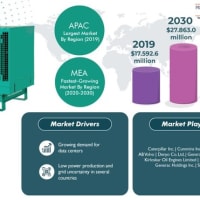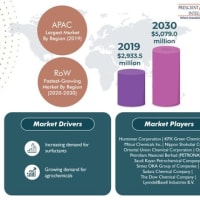A lot of things in our life are made of plastics, due to their wide availability and the fact that objects made from such materials are rather cost-effective. However, with the increasing production of plastics, the problem of their sustainable disposal is also becoming graver by the day. As plastics aren’t biodegradable, they lead to pollution on land, in water, and even inside bodies of animals. As per the National Geographic Society, around 8.3 billion tons of plastics have been produced till now, and most of it has been in the form of disposable products, but only 9% of it has been recycled.
Therefore, due to the strengthening focus on reusing such materials as much as possible, the plastic recycling market is projected to grow from $41,238.8 million in 2018 to $64,139.7 million by 2024, at an 8.6% CAGR during 2019–2024. Governments in North America and Europe have established several centers for plastic waste collection and sorting, and in some places, recyclers are being offered monetary incentives. Additionally, policies to decrease plastic waste production have been implemented in many places across the world.

Historically, Europe sent most of its waste to China for recycling, but with the banning of plastic waste import there, European nations have had to reroute their exports to South Asian countries, which have fairly low reprocessing capacities. As a result, recycling is picking up pace in Europe, with a large chunk of the waste being dumped in landfills and incinerators. In 2018, the European Commission adopted the Plastics Strategy, which is aimed at developing better reprocessing technologies. Further, $270 million (EUR 250 million) has been invested to create plastics with better recyclability.
Sheets, packaging, wires and cables, pipes, and molded products are the various sources for recycled plastics. Among these, the largest volume of plastics for recycling came from packaging materials, during 2014–2018. As packaging materials are designed for a short life, they produce considerable amounts of waste. Further, with enhancements in the recycling process, packaging materials are able to maintain their storage consistency and visual attributes. Additionally, the reuse of plastics for the same product they were originally meant for is being encouraged, as reprocessing requires low electricity and is more environmental-friendly compared to the manufacturing of virgin materials.
Food and beverage, household and personal care, automotive, and construction are the most significant industries, from the point of plastic waste generation for reprocessing. Among these, the food and beverage sector contributed the largest volume of the materials for recycling during the historical period. The reason is that the sector employs several kinds of plastics, including high-density polyethylene (HDPE), polyethylene terephthalate (PET), polypropylene (PP), low-density polyethylene (LDPE), and polystyrene (PS), for storage, packaging, preservation, transportation, and aesthetic purposes. People throw these away after use, and they are then used by reprocessing plants.
Asia-Pacific is currently the largest plastic recycler, due to its high reprocessing capacity, which is itself a result of the high import as well as locally generated volumes of such waste. Additionally, the low labor cost makes manual activities, such as cleaning, collection, and sorting, cost-effective, which is another reason for the high recycling rate of APAC. During the forecast period, plastic recycling market growth in Europe would be the fastest, as a result of the establishment of more reprocessing plants and strict targets to ensure environment sustainability.
Thus, as plastic waste mounts immense pressure on governments to do something about it, the market for its reprocessing and reuse will keep growing.
Therefore, due to the strengthening focus on reusing such materials as much as possible, the plastic recycling market is projected to grow from $41,238.8 million in 2018 to $64,139.7 million by 2024, at an 8.6% CAGR during 2019–2024. Governments in North America and Europe have established several centers for plastic waste collection and sorting, and in some places, recyclers are being offered monetary incentives. Additionally, policies to decrease plastic waste production have been implemented in many places across the world.

Historically, Europe sent most of its waste to China for recycling, but with the banning of plastic waste import there, European nations have had to reroute their exports to South Asian countries, which have fairly low reprocessing capacities. As a result, recycling is picking up pace in Europe, with a large chunk of the waste being dumped in landfills and incinerators. In 2018, the European Commission adopted the Plastics Strategy, which is aimed at developing better reprocessing technologies. Further, $270 million (EUR 250 million) has been invested to create plastics with better recyclability.
Sheets, packaging, wires and cables, pipes, and molded products are the various sources for recycled plastics. Among these, the largest volume of plastics for recycling came from packaging materials, during 2014–2018. As packaging materials are designed for a short life, they produce considerable amounts of waste. Further, with enhancements in the recycling process, packaging materials are able to maintain their storage consistency and visual attributes. Additionally, the reuse of plastics for the same product they were originally meant for is being encouraged, as reprocessing requires low electricity and is more environmental-friendly compared to the manufacturing of virgin materials.
Food and beverage, household and personal care, automotive, and construction are the most significant industries, from the point of plastic waste generation for reprocessing. Among these, the food and beverage sector contributed the largest volume of the materials for recycling during the historical period. The reason is that the sector employs several kinds of plastics, including high-density polyethylene (HDPE), polyethylene terephthalate (PET), polypropylene (PP), low-density polyethylene (LDPE), and polystyrene (PS), for storage, packaging, preservation, transportation, and aesthetic purposes. People throw these away after use, and they are then used by reprocessing plants.
Asia-Pacific is currently the largest plastic recycler, due to its high reprocessing capacity, which is itself a result of the high import as well as locally generated volumes of such waste. Additionally, the low labor cost makes manual activities, such as cleaning, collection, and sorting, cost-effective, which is another reason for the high recycling rate of APAC. During the forecast period, plastic recycling market growth in Europe would be the fastest, as a result of the establishment of more reprocessing plants and strict targets to ensure environment sustainability.
Thus, as plastic waste mounts immense pressure on governments to do something about it, the market for its reprocessing and reuse will keep growing.




















※コメント投稿者のブログIDはブログ作成者のみに通知されます